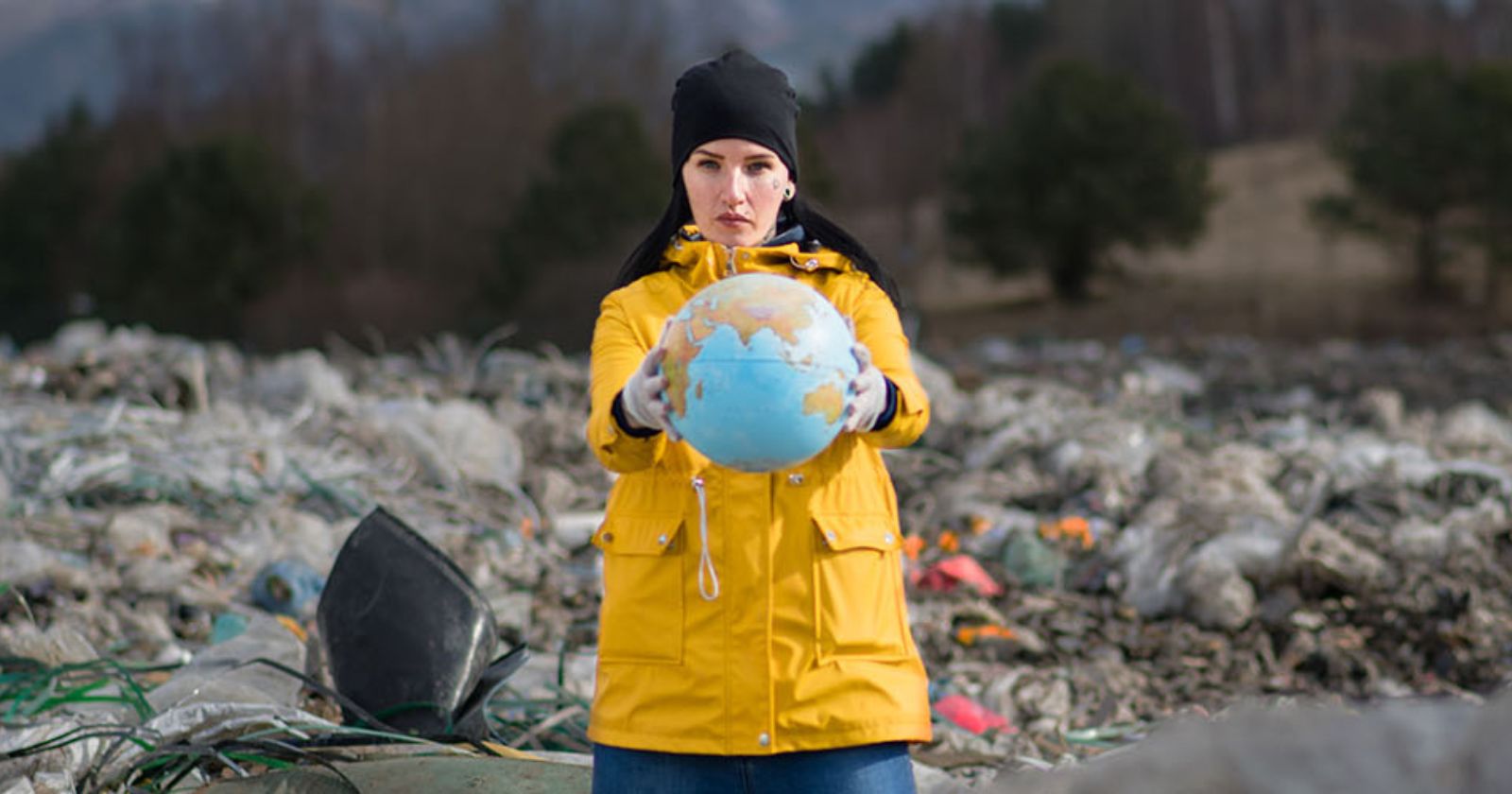The fashion industry, which is worth $1.5 trillion globally1 and employs more than 300 million people along the value chain2, is a significant contributor to textile waste & carbon emissions, and, according to Nature, responsible for as much as 10% of all global pollution, making it the second most polluting industry after aviation3.
We’ve collected a wide range of statistics that illustrate this and hope they will encourage you to embrace sustainable fashion, cut down on textile waste, and shop second hand more often, rather than buying new clothes.
We’ve sourced these statistics from as many different sources as possible, including industry reports, scientific papers, and more. We’ve always used the most up-to-date stats possible, although in some cases these are a few years old, depending on the availability of data.
Textile Production & Fast Fashion Statistics
Fast fashion – the increase in numbers of styles and collections of clothing, along with lower prices – has led to a significant increase in fashion waste. The average consumer is buying more clothes, wearing them less, and creating more waste. Additionally, inefficient manufacturing practices mean that clothing ends end up on the cutting room floor, rather than being recycled, and many companies still burn millions of dollars of unsold clothes at the end of each season (energy recovery makes this better than landfill, but it’s still wasteful).
- Between 2000 and 2015, clothing production doubled2.
- Another study states that between 1975 and 2018, global per-capita textile production increased from 5.9 kg per person to 13kg per person4.
- Globally, we consume 62 million tonnes of textiles per year. By 2030, this is expected to reach 102 million tonnes3.
- Because people are buying more new clothes, they are using them less: the average piece of clothing is worn 36% fewer times now than it was 15 years ago2. This is most extreme in Western countries, such as the US, but China is catching up. In China, clothing utilization has decreased by 70% over the last 15 years2.
- The fast fashion trend means clothing brands are now producing almost twice as many clothing collections per year than they were before 200020.
- The world economy would benefit to the tune of $192 billion in 2030 if the industry could successfully address the environmental and societal issues caused by current strategies2.
- By throwing away clothes prematurely, customers miss out on $460 billion of value every year2. That’s almost $60 per person.
- Lower costs encourage increased buying. Despite buying more clothing, the average spend per person on clothing (in the EU) has decreased from 30% of income in the 1950s to just 5% in 20205.
- The average American consumer purchases one new item of clothing every 5.5 days2. That’s 5.5 items of clothing per month, or 66 items per year.
- The industry accounts for 60% of global fibre production2.
- Polyester, a synthetic textile, accounts for 51% of textiles produced – that’s 54 million tonnes. Cotton is second with 25% at 26 million tonnes (2017)3.
- Some studies estimate textile waste during manufacturing as high as 25%6. Other studies estimate 15% of materials end up on the cutting room floor.7
To combat these trends, eco-conscious consumers are increasingly buying from sustainable fashion brands or buying used clothing instead of new.
Fashion Industry Transportation Statistics
Most fashion garments are not made in the countries where they are sold. In many cases, the creation and processing of the fabric and the production of the clothing will involve multiple countries. This means significant shipping, which increases pollution:
- A significant proportion of textiles sold are made in China, which exports $158.4 billion of clothing every year, plus an additional $109.9 billion of other textiles8.
- The way we transport garments makes a big difference. Quantis estimates that swapping 1% of garment transportation to air (from ship) results in a 35% increase in CO2 emissions10.
Fashion Industry Energy Usage & Waste Statistics
It takes a lot of energy and resources to turn raw materials into the clothes we buy in the shops. You might be surprised how much your fashion footprint is and just how much greenhouse gas emissions are created during a typical production process:
- Textiles generate more greenhouse gases per unit of material than almost any other industry (except aluminum)9.
- The fashion industry is responsible for 8.1% of global greenhouse gas emissions10. In 2016, when this study was done, apparel and footwear industry produced an estimated 3,990 million metric tons C02eq10.
- The United Nations estimates that the industry produced up to 10% of total global C02 emissions. This is more than 1.7 billion tonnes of C02 annually11 – that’s about 0.2 tonnes of C02 per person on the planet, just for one industry.
- The way textiles are grown has a big impact on energy usage. Cultivating cotton organically leads to 3.5 times less CO2 being emitted than using traditional cultivation methods3.
- The fashion industry is projected to grow 49% between 2016 and 2030. If greenhouse gas emissions from the industry grow at the same rate, this would lead to 5,945 million metric tons C02eq being produced in 203010.
- To hit a target of 50% reduction in emissions by 2030, the fashion industry would need to hit a renewable energy target of 78%10.
- In 2015, the textiles industry used 98 million tons of non-renewable resources, including oil, fertilizers, and chemicals. If industry growth continues unchecked, this will reach 300 million tons of non-renewable resources by 2015.2
- The textile industry uses more than 15,000 different chemicals12.
- Cotton crops alone account for 6% of global pesticide production (by financial value)13.
- CO2 emissions are also affected heavily by usage: it is estimated that for a cotton t-shirt, 35% of lifetime CO2 emissions are generated during production, and 52% are producing during use (when washing)14.
The data is clear: companies must embrace sustainable energy sources sooner rather than later.
Fashion Industry Water Waste Statistics
The fashion industry is a huge contributor to water waste and water pollution, including plastic pollution. Water is used heavily in the cultivation of cotton, as well as in wet processes such as bleaching, dyeing, and finishing. Even simple cotton clothes use a surprisingly large amount of water to create:
- The fashion industry is responsible for 20% of water waste worldwide.15
- Approximately 35% of all oceanic primary microplastic pollution is caused by the fashion industry4. That’s 190,000 tonnes of microplastic waste entering the oceans each year due to fashion.
- The textile industry uses an estimated 79 billion cubic meters of water per year16. That’s 10 cubic meters of water for every person on the planet, or 10,000 liters per person.
- To produce one cotton shirt the fashion industry uses 2700 liters of water16. That’s the equivalent of 2.5 years of drinking water or 24 bathtubs.
- Between 2015 and 2050 the textiles industry is expected to add 22 million tons of microfibers to the ocean16.
- On average, 200 tonnes of water are used to produce one tonne of textiles17.
- It is estimated that every year, 44 trillion litres of water are used to irrigate textile crops3.
- 95% of water used in textile irrigation, almost 40 trillion litres, is linked to the production of cotton18.
- It is estimated than 20% of water lost from the Aral Sea was directly linked to water used to grow cotton for textile use in the EU19.
Many sustainable fashion brands create clothes using less water, but these processes are more expensive. Organic cotton farming, for example, is farmed without using additional water or fertilizers, but this results in a lower yield. In a competitive fashion market, many brands would still rather use cheaper methods so that they can sell more cheaper clothes.
Post-Consumer Textile Waste and Landfill Statistics
Most clothes that enter the supply chain end up in landfills:
- 87% of the total fibre input used for clothing is either landfilled or incinerated2.
- On average, Americans throw away 81 lbs of textiles each, every year. This amounts to 26 billion pounds of textile waste in the United States alone20.
- Landfilled textile waste increased by 40% in the USA between 1999 and 200921.
- Less than 1% of material used to produce clothing is recycled into new clothing2.
- Textiles account for 22% of total global mixed waste22.
- The average consumer in the USA and UK wastes 30kg of textiles each every year23.
- In 2015, just 15% of post-consumer textile waste was collected for recycling2.
References
- https://www.statista.com/topics/5091/apparel-market-worldwide/
- https://www.ellenmacarthurfoundation.org/assets/downloads/publications/A-New-Textiles-Economy_Full-Report_Updated_1-12-17.pdf
- https://www.nature.com/articles/s43017-020-0039-9
- Peters, G. M., Sandin, G. & Spak, B. Environmental prospects for mixed textile recycling in Sweden. ACS Sustain. Chem. Eng. 7, 11682–11690 (2019).
- http://www.europarl.europa.eu/thinktank/en/document.html?reference=EPRS_BRI%282019%29633143 (2019).
- http://www.reverseresources.net/about/white-paper
- Cooklin, G. Garment Technology for Fashion Designers (Blackwell, 1997)
- https://www.just-style.com/analysis/changing-trends-in-world-textile-and-apparel-trade_id134353.aspx (2018)
- Wang, L., Li, Y. & He, W. The energy footprint of China’s textile industry: Perspectives from decoupling and decomposition analysis. Energies 10, 1461 (2017)
- https://quantis-intl.com/wp-content/uploads/2018/03/measuringfashion_globalimpactstudy_full-report_quantis_cwf_2018a.pdf
- https://unfccc.int/news/un-helps-fashion-industry-shift-to-low-carbon
- Roos, S., Jönsson, C., Posner, S., Arvidsson, R. & Svanström, M. An inventory framework for inclusion of textile chemicals in life cycle assessment. Int. J. Life Cycle Assess. 24, 838–847 (2019)
- https://issuu.com/pan-uk/docs/cottons_chemical_addiction_-_update?e=28041656/62705601 (2018)
- https://prod-drupal-files.storage.googleapis.com/documents/resource/public/International%20Carbon%20Flows%20-%20 Clothing%20-%20REPORT.pdf (2011)
- https://unece.org/fileadmin/DAM/RCM_Website/RFSD_2018_Side_event_sustainable_fashion.pdf
- https://sustainablecampus.fsu.edu/blog/clothed-conservation-fashion-water
- Anguelov, N. The Dirty Side of the Garment Industry: Fast Fashion and its Negative Impact on Environment and Society (CRC, Taylor & Francis, 2015)
- Pfister, S., Bayer, P., Koehler, A. & Hellweg, S. Projected water consumption in future global agriculture: Scenarios and related impacts. Sci. Total. Environ. 409, 4206–4216 (2011)
- Chapagain, A. K., Hoekstra, A. Y., Savenije, H. H. G. & Gautam, R. The water footprint of cotton consumption: an assessment of the impact of worldwide consumption of cotton products on the water resources in the cotton producing countries. Ecol. Econ. 60, 186–203 (2006)
- https://www.mckinsey.com/business-functions/sustainability/our-insights/style-thats-sustainable-a-new-fast-fashion-formula
- Office of Solid Waste, United States Environmental Protection Agency. Municipal solid waste in the United States: Facts and figures (EPS, 2010)

James is a copywriter based in the UK. He writes on sustainability, finance, tech, and anything else that interests him. He likes tea.



